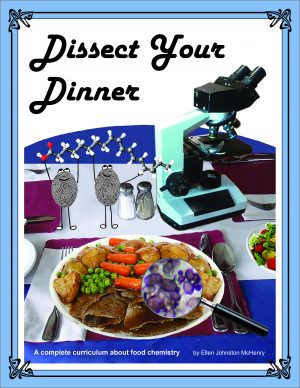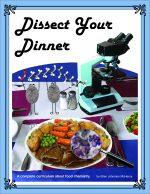- Description
Description
This is a complete curriculum for ages 11 to 16. Check out the free sample chapters below (and free sample of teacher’s activity section).
NOTE: This curriculum was updated on 2-15-2024. The digital download now gives you extra (optional) nutrition worksheets, plus some extra activities in various chapters.
Free sample chapters:
DYD sample of teacher section (lo res)
Here is a summary of what is in each chapter:
Chapter 1: Structure of water molecule, structure of atoms, why water is a polar molecule, the chemistry of salt NaCl, the structure of a glucose (simple sugar) and sucrose (combination of glucose and fructose), definition of enzymes, and a look at how the enzyme sucrase tears apart sucrose.
Chapter 2: Carbonation, carbon dioxide, dissolved gases, mixtures, caffeine molecule, benzene ring, artificial colors, preservatives such as potassium benzoate and sodium benzoate, phosphoric acid, water’s ions (hydrogen ion and hydroxide ion), pH definition and the pH scale, pasteurization, homogenization, lactobacillus, the proteins in milk, peptide bonds, peptidases, lactose and lactase, colloids, the Tyndall effect.
Chapter 3: How butter is made, the beta-carotene molecule and how it is chopped in half to form two retinols, triglycerides, protein micelles in milk, chemistry of curdling milk, microorganisms in cheese, lactic acid fermentation by bacteria, ethanol fermentation by yeast, amylose and amylopectin starch, amylase enzyme, amino acids, the chemistry of the protein gluten and why it creates problems, the Maillard reaction, leavening with baking soda and baking powder.
Chapter 4: Emulsions and emulsifiers, anatomy of leaves, chloroplasts, chlorophyll, phtyochemicals (polyphenols such as flavonoids, resveratrol, curcumin, tannins), the history of the discovery of vitamins and information about the vitamins, comparison of type of salad greens (iceberg, red leaf, endive, spinach), fiber, microbiome in our gut, cellulose and cellulase.
Chapter 5: Capsaicin, anatomy of bean pods and seeds, chemistry of bean seeds (oil bodies, protein bodies, starch granules), endosperm, phytohemagglutinin, raffinose in beans, solanine in potatoes and other nightshades, potatoes and sweet potatoes, microscopic comparison of starch granules, the anatomy of muscle tissue, myoglobin, hemoglobin, omega-3 fatty acids, saturated and unsaturated fats, cis and trans fats, plant-based meats and leghemoglobin taken from soybean roots.
Chapter 6: Anatomy of eggs, chemistry of beating egg whites (meringue), why eggs can make custard, thickening with starches, vegetable shortening, hydrogenating oils, physics of pie crust, collagen-based gelatins, apsics, history of Jell-O, why whipped cream gets thick, agar, pectin, carrageenan, chocolate (theobromine), caffeine, types of sugar, caramelization, menthol, xylitol, stevia, artificial sweeteners.
FAQ’s:
1) Is there a prerequisite? Do I need to do “The Elements” first? I have tried to design this book so that a prerequisite isn’t necessary, but students who have had a bit of chemistry before this will (of course) find it easier.
2) Is this book appropriate for early high school? The science content is certainly fine for high school. The only question is whether the students are okay with cartoon characters and funny jokes in their textbook.
3) Do I have to do all the activities? No, just choose the ones that are a good fit for your situation.




